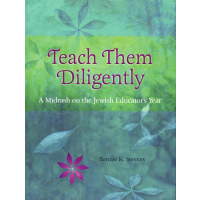Purim Reflections for Educators: Teaching As Celebration
"A person in a joyful mood can learn more in one hour than a depressed person can learn in many hours."
- Rabbi Chaim Volozhin, Ruach Chaim (commentary on Pirkei Avot)
In Teach Them Diligently: A Midrash on the Jewish Educator's Year, Bonnie K. Stevens takes a fresh look at the Jewish holidays to help seasoned and novice teachers see even day-to-day tasks as crucial parts of the sacred mission of Jewish education.
"The observance of Purim reflects Judaism's balanced, comprehensive view of lfe, one that encompasses both recognition of life's troubles and affirmations of its joys, both our need for occasional self-indulgence and our enduring obligations to others," she writes, observing Purim's interplay between fasting to remember the hardship of the Persian Jews, merriment in celebration, and commitment to the poor.
Similarly, thinking about the way Purim is observed can help Jewish educators find balance in their work. "Study is, of course, central to Jewish education, just as reading the megillah is central to Purim observance. Our classes will always include Hebrew and history lessons, and students will always need to do some hard work to learn the things informed, committed Jewish adults need to know," she writes.
"But on Purim we learn not only by hearing the story of Esther and Mordechai, but also by taking part in celebrations that help us share their feelings of joy, gratitude, and triumph. Similarly, in Jewish education, we needn't feel that any deviation from strict attention to books means abandoning learning. Hard work can be balanced by joyful play, and our classes can be comprehensive enough to include activities that give students a sense of release from routine while still helping them learn about and grow to treasure Judaism."
The visual arts, in particular, offer an important avenue toward that balance. "For some students, art provides ways of expressing ideas, emotions, and enthusiasms they find it difficult to articulate. It's a mistake to think only younger students should do art projects," Stevens writes. "We use art to reinforce lessons about Judaism, to give students chances to express their ideas about what they've studied, and to provide them with experiences that will make them more enthusiastic about Judaism."
To read more about Purim and its message for educators, click here.
Don’t forget to subscribe to our newsletter and connect with us on social media!




